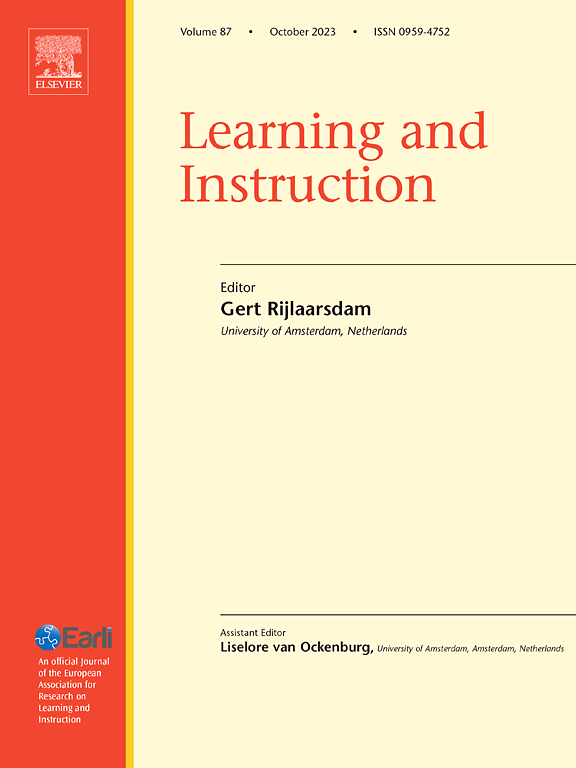Longitudinal evidence on the potential adverse impact of grade repetition on self-concept and grit
IF 4.9
1区 教育学
Q1 EDUCATION & EDUCATIONAL RESEARCH
引用次数: 0
Abstract
Background
The impact of grade repetition on social-emotional skills is well-researched but somewhat inconclusive. Evidence suggests that lower competitive groups can boost self-concept through social comparison. Our main hypothesis is that measuring self-concept just before students are notified of repetition may capture unintended effects, leading to a “rebound effect”. The main objective is to compare the evolution of self-concept and grit between students who were promoted and those who began repeating in 6th grade using matched samples.
Method
The sample comprised 5999 students (49 % girls) who were assessed at two-time points, 4th and 8th grade, with mean ages of 9.78 years (SD = 0.29) and 13.91 years (SD = 0.44), respectively. The first assessment was conducted two years before the first possible grade repetition to avoid the impact on self-concept and grit from the threat of repetition. To control selection bias, the repeater group (n = 762) was matched with a promoted group using propensity score matching, including sociodemographic predictors, prior achievement, and pre-repetition. The potential adverse impact of repetition was estimated using a two-level hierarchical-linear-analysis.
Results
Adolescents experienced a clear drop in self-concept and grit over time. However, after accounting for sociodemographic differences, prior achievement, and school-level variables, the drop is significantly larger for grade repeaters compared to those who have been promoted. Moreover, grade repetition at later stages is associated with a more adverse impact.
Conclusions
Understanding the impact of grade repetition before students face the threat of repeating can help educators and policymakers develop strategies to prevent negative consequences for at-risk students.
年级重复对自我概念和毅力潜在不利影响的纵向证据
重复年级对社交情感技能的影响已经得到了充分的研究,但有些不确定。有证据表明,竞争力较低的群体可以通过社会比较来增强自我概念。我们的主要假设是,在学生被告知要重复之前测量自我概念可能会捕捉到意想不到的效果,导致“反弹效应”。本研究的主要目的是利用匹配样本,比较六年级升班生和复读生在自我概念和毅力方面的演变。方法在4年级和8年级两个时间点对5999名学生进行调查,其中女生占49%,平均年龄分别为9.78岁(SD = 0.29)和13.91岁(SD = 0.44)。第一次评估在第一次可能的年级重复前两年进行,以避免重复的威胁对自我概念和毅力的影响。为了控制选择偏差,使用倾向评分匹配将重复者组(n = 762)与提升组进行匹配,包括社会人口学预测因素、先前成就和预重复。使用两级层次线性分析估计重复的潜在不利影响。结果随着时间的推移,青少年的自我概念和毅力明显下降。然而,在考虑了社会人口统计学差异、以前的成就和学校水平变量之后,与升职者相比,留级者的下降幅度要大得多。此外,后期的年级重复与更不利的影响有关。结论在学生面临重复威胁之前了解年级重复的影响可以帮助教育工作者和政策制定者制定策略,以防止对有风险的学生产生负面影响。
本文章由计算机程序翻译,如有差异,请以英文原文为准。
求助全文
约1分钟内获得全文
求助全文
来源期刊

Learning and Instruction
Multiple-
CiteScore
11.30
自引率
4.80%
发文量
109
期刊介绍:
As an international, multi-disciplinary, peer-refereed journal, Learning and Instruction provides a platform for the publication of the most advanced scientific research in the areas of learning, development, instruction and teaching. The journal welcomes original empirical investigations. The papers may represent a variety of theoretical perspectives and different methodological approaches. They may refer to any age level, from infants to adults and to a diversity of learning and instructional settings, from laboratory experiments to field studies. The major criteria in the review and the selection process concern the significance of the contribution to the area of learning and instruction, and the rigor of the study.
 求助内容:
求助内容: 应助结果提醒方式:
应助结果提醒方式:


